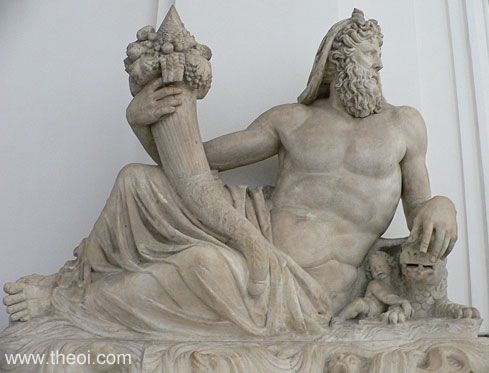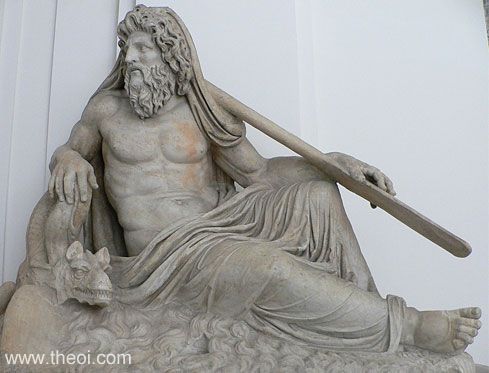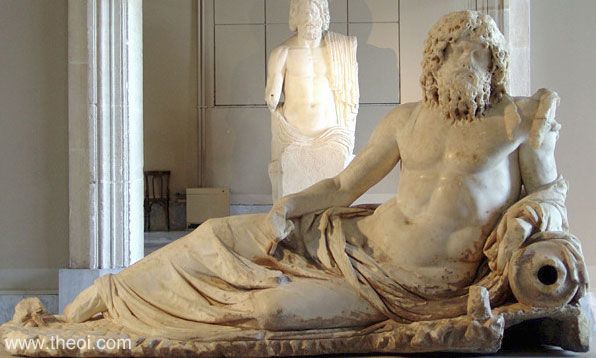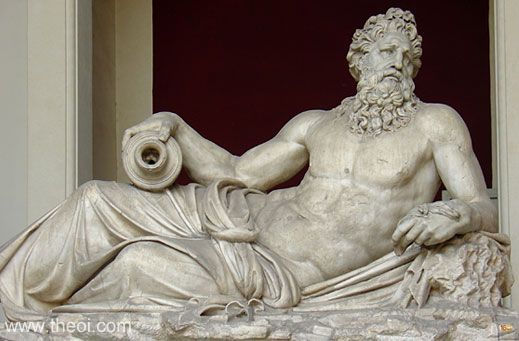POTAMOI CULT
Greek Name
Ποταμοι
Transliteration
Potamoi
Latin Spelling
Potami
Translation
Flumina

THE POTAMOI were the gods of the rivers.
Local rivers were worshipped throughout Greece and its colonies. They were regarded as protectors of the young and gods of agricultural bounty.
In classical sculpture river-gods were usually depicted as reclining, bearded men, robed with bared chests. Their standard attributes included the cornucopia (horn of plenty), water-jug and oar.
CLASSICAL LITERATURE QUOTES
GENERAL CULT
I. CULT STATUES
Pausanias, Description of Greece 8. 24. 12 (trans. Jones) (Greek travelogue C2nd
A.D.) :
"The images of all Rivers except the Neilos (Nile) in Aigyptos (Egypt) are made of white marble."
Aelian, Historical Miscellany 2. 33 (trans. Wilson) (Greek rhetorician C2nd to 3rd
A.D.) :
"The nature of rivers, and their streams, are visible to us. But men who honour them, and have statues made
of them, in some cases set up anthropomorphic statues, while others give them bovine form. A likeness to cattle
is attributed by the Stymphalians to Erasinos and Metope, by the Spartans to the Eurotas, by the Sikyonians and
Phliasians to the Asopos, and by the Argives to the Kephisos. The form of a man is adopted by the Psophidians
for the Erymanthos, and by the Heraians for the Alpheios; the Kherronesians from Knidos treat the same river in
the same way. The Athenian portray the Kephisos as a human bust but with horns just showing. And in Sikelia the
Syrakousans represent Anapos as a man, whereas they honoured the spring Kyane with the statue of a woman. The
Egestans honour the Porpax, Krimisos, and Telmessos in the form of men. The inhabitants of Akragas portray the
river of the same name as a handsome boy and make sacrifice to him. They also made an offering at Delphoi,
carving an ivory statue with the river's name inscribed on it, and the statue is of a boy."
II. PRIESTS OF THE RIVERS
Valerius Flaccus, Argonautica 6. 295 ff (trans. Mozley) (Roman epic C1st A.D.)
:
"Aquites, priest of mighty Phasis, consecrated to his native waters . . . poplar decked his brow and his
temples were conspicuous with its gray entwining sprays."
[N.B. White and black poplars are commonly found growing along the banks of Greek and Italian rivers. It is
possible that priests of the river-gods would have worn such a crown.]
III. DEDICATIONS OF LOCKS OF HAIR
The Rivers were worshipped as protectors of the young, and youths would dedicate their uncut locks to the local stream at their coming-of-age.
See River-Gods Protectors of the Young
CULT IN ATTICA (SOUTHERN GREECE)
I. ATHENS (ATHENAI) Main City of Attica (Attika)
Pausanias, Description of Greece 1. 37. 3 (trans. Jones) (Greek travelogue C2nd A.D.)
:
"By the river [Kephisos in Athens] is a statue of Mnesimakhe, and a votive statue of her son cutting his
hair as a gift for Kephisos. That this habit has existed from ancient times among all the Greeks may be inferred
from the poetry of Homer."
Aelian, Historical Miscellany 2. 33 (trans. Wilson) (Greek rhetorician C2nd to 3rd
A.D.) :
"The nature of rivers, and their streams, are visible to us. But men who honour them, and have statues made
of them, in some cases set up anthropomorphic statues, while others give them bovine form. A likeness to cattle
is attributed . . . by the Argives to the Kephisos [i.e. the other river Kephisos] . . . The Athenian portray
the Kephisos [i.e. their river Kephisos] as a human bust but with horns just showing."
II. OROPUS (OROPOS) Town in Attica
Pausanias, Description of Greece 1. 34. 3 (trans. Jones) (Greek travelogue C2nd A.D.)
:
"[In the sanctuary of Amphiaraus in Oropos, Attika :] The altar shows parts . . . The fifth is dedicated to
the Nymphai and Pan, and to the rivers Akheloos and Kephisos."
For MORE information on the Athenian river see KEPHISOS
CULT IN SICYONIA (SOUTHERN GREECE)
I. SICYON (SIKYON) & PHLIUS (PHLIOUS) Towns of Sicyonia
Pausanias, Description of Greece 5. 22. 6 :
"The Phliasians also dedicated [statues at Olympia :] a Zeus, the daughters of Asopos, and Asopos
himself."
Aelian, Historical Miscellany 2. 33 (trans. Wilson) (Greek rhetorician C2nd to 3rd
A.D.) :
"A likeness to cattle is attributed . . . by the Sikyonians and Phliasians to the Asopos."
For MORE information on the Sikyonian river see ASOPOS
CULT IN ARGOLIS (SOUTHERN GREECE)

I. ARGOS Main City of Argolis
Pausanias, Description of Greece 2. 20. 6 (trans. Jones) (Greek travelogue C2nd A.D.)
:
"[At Argos] is a sanctuary of Kephisos. It is said that the water of this river was not utterly destroyed
by Poseidon [i.e. when he dried up the Argive streams in the summer], but that just in this place, where the
sanctuary is, it can be heard flowing under the earth."
Aelian, Historical Miscellany 2. 33 (trans. Wilson) (Greek rhetorician C2nd to 3rd
A.D.) :
"The nature of rivers, and their streams, are visible to us. But men who honour them, and have statues made
of them, in some cases set up anthropomorphic statues, while others give them bovine form. A likeness to cattle
is attributed . . . by the Argives to the Kephisos."
II. NEMEA Town in Argolis
Statius, Thebaid 6. 275 ff (trans. Mozley) (Roman epic C1st A.D.) :
"Next in order [amongst the statues at Nemea] is seen father Inachus reclining leftward on the mound of a
reedy bank and letting the streming urn flow free."
For MORE info on the Argive rivers see INAKHOS, KEPHISOS & ASTERION
CULT IN LACEDAEMONIA (SOUTHERN GREECE)
I. SPARTA Main City of Lacedaemonia (Lakedaimonia)
Strabo, Geography 8. 5. 3 (trans. Jones) (Greek geographer C1st B.C. to C1st A.D.)
:
"And Sophokles says, ‘by the two Lapersai [i.e. the Dioskouroi], I swear, by Eurotas third, by the
gods in Argos and about Sparta.’" [N.B. Eurotas and the Dioskouroi were the indigenous gods of
Sparta.]
Pausanias, Description of Greece 3. 12. 8 (trans. Jones) (Greek travelogue C2nd A.D.)
:
"There is also a sanctuary [at Sparta] of [the Seilenos] Maron and of [the River] Alpheios."
Aelian, Historical Miscellany 2. 33 (trans. Wilson) (Greek rhetorician C2nd to 3rd
A.D.) :
"The nature of rivers, and their streams, are visible to us. But men who honour them, and have statues made
of them, in some cases set up anthropomorphic statues, while others give them bovine form. A likeness to cattle
is attributed . . . by the Spartans to the Eurotas."
For MORE information on the Lakonian river see EUROTAS
CULT IN ELIS (SOUTHERN GREECE)
I. OLYMPIA Village & Sanctuary in Elis
Bacchylides, Fragment 5 (trans. Campbell, Vol. Greek Lyric IV) (C5th B.C.)
:
"Sing in praise of Zeus Kronides, Olympian, ruler of gods, and Alpheios, tireless stream."
Pausanias, Description of Greece 5. 10. 6 (trans. Jones) (Greek travelogue C2nd A.D.)
:
"[Amongst the sculptural figures on the pediment of the temple of Zeus at Olympia :] At the very edge lies
Kladeos, the river which, in other ways also, the Eleans honour most after Alpheios . . . Then the pediment
narrows again, and in this part of it is represented Alpheios."
Pausanias, Description of Greece 5. 15. 6 :
"There are behind the Heraion [at Olympia] altars of the river Kladeos and of Artemis."
Pausanias, Description of Greece 5. 13. 11 :
"[At Olympia :] Every year the soothsayers . . . bring the ash from the town-hall [i.e. from sacrifices to
Zeus], and making it into a paste with the water of the Alpheios they daub the altar therewith. But never may
the ash be made into past with other water, and for this reason the Alpheios is thought to be of all Rivers the
dearest to Zeus Olympios."
Pausanias, Description of Greece 5. 14. 6 :
"After the altars I have enumerated [at Olympia] there is one on which they sacrifice to Alpheios and
Artemis together. The cause of this Pindar, I think, intimates in an ode, and I give it in my account of
Letrinoi. Not far from it stands another altar of Alpheios."
Pausanias, Description of Greece 5. 24. 7 :
"[At Olympia] they have dedicated images of Pelops and of the river Alpheios respectively.
Pausanias, Description of Greece 8. 20. 2 :
"Leukippos [mythical Eleian hero] was growing his hair long for the river Alpheios."
[N.B. Youths dedicated the uncut locks of their childhood to the local river-god.]
Ptolemy Hephaestion, New History Book 5 (summary from Photius, Myriobiblon 190)
(trans. Pearse) (Greek mythographer C1st to C2nd A.D.) :
"As a hommage to the river Alpheios, after a victory at [the Games of] Olympia, Herakles called with his
name the letter ‘alpha’ which he placed at the head of the alphabet."
For MORE information on the Eleian river see ALPHEIOS
CULT IN ARCADIA (SOUTHERN GREECE)

I. STYMPHALUS (STYMPHALOS) Town in Arcadia (Arkadia)
Aelian, Historical Miscellany 2. 33 (trans. Wilson) (Greek rhetorician C2nd to 3rd
A.D.) :
"The nature of rivers, and their streams, are visible to us. But men who honour them, and have statues made
of them, in some cases set up anthropomorphic statues, while others give them bovine form. A likeness to cattle
is attributed by the Stymphalians to Erasinos and Metope."
II. PSOPHIS Town in Arcadia
Pausanias, Description of Greece 8. 24. 12 (trans. Jones) (Greek travelogue C2nd
A.D.) :
"The people of Psophis [in Arkadia] have also by the side of the [river] Erymanthos a temple and image of
Erymanthos."
Aelian, Historical Miscellany 2. 33 (trans. Wilson) (Greek rhetorician C2nd to 3rd
A.D.) :
"The nature of rivers, and their streams, are visible to us. But men who honour them, and have statues made
of them, in some cases set up anthropomorphic statues, while others give them bovine form . . . The form of a
man is adopted by the Psophidians for the Erymanthos."
III. LYMAX R. & NEDA R. Rivers in Arcadia
Pausanias, Description of Greece 8. 41. 4 - 6 (trans. Jones) (Greek travelogue C2nd
A.D.) :
"The river Lymax (‘After-Birth’) falls into the Neda [in Arkadia]. Where the streams meet is
the sanctuary of Eurynome, a holy spot from of old and difficult of approach because of the roughness of the
ground. Around it are many cypress trees, growing close together. Eurynome is believed by the people of Phigalia
to be a surname of Artemis. Those of them, however, to whom have descended ancient traditions, declare that
Eurynome was a daughter of Okeanos, whom Homer mentions in the Iliad, saying that along with Thetis she
received Hephaistos. On the same day in each year they open the sanctuary of Eurynome, but at any other time it
is a transgression for them to open it. On this occasion sacrifices also are offered by the state and by
individuals. I did not arrive at the season of the festival, and I did not see the image of Eurynome; but the
Phigalians told me that golden chains bind the wooden image, which represents a woman as far as the hips, but
below this a fish. If she is a daughter of Okeanos, and lives with Thetis in the depth of the sea, the fish may
be regarded as a kind of emblem of her. But there could be no probable connection between such a shape and
Artemis."
[N.B. The fish-tailed Eurynome is a river-goddess--of either the Lymax or the Neda.]
IV. STYX R. River in Arcadia
Strabo, Geography 8. 8. 4 (trans. Jones) (Greek geographer C1st B.C. to C1st A.D.)
:
"And near Pheneus [in Arkadia] is also the water of the Styx, as it is called--a small stream of deadly
water which is held to be sacred."
For MORE info on these rivers see LADON, ERYMANTHOS, STYX, ERASINOS
CULT IN BOEOTIA (CENTRAL GREECE)
I. Near THESPIAE (THESPIAI) Town in Boeotia (Boiotia)
Philostratus the Elder, Imagines 1. 23 (trans. Fairbanks) (Greek rhetorician C3rd
A.D.) :
"A youth [Narkissos] just returned from the hunt stands over a pool . . . The cave is sacred to Akheloos
and the Nymphai, and the scene is painted realistically. For the statues are of a crude art and made from a
local stone; some of them are worn away by time, others have been mutilated by children of cowherds or shepherds
while still young and unaware of the presence of the god [i.e. Dionysos]." [N.B. The pool of Narkissos was
located at place called Donakon near Thespiai (cf. Pausanias 9.31.7).]
CULT IN PHOCIS (CENTRAL GREECE)
I. DELPHI (DELPHOI) Town & Sanctuary in Phocis (Phokis)
Aeschylus, Eumenides 20 ff (trans. Weir Smyth) (Greek tragedy C5th B.C.) :
"[The Pythia, prophetess of the oracle at Delphoi, invokes the gods :] These are the gods I place in the
beginning of my prayer [Gaia, Themis, Phoibe and Apollon] . . . and I worship [also] the Nymphai where the
Korykian rock is hollow, the delight of birds and haunt of gods. Bromios [Dionysos] has held the region . . . I
call on the streams of Pleistos and the strength of Poseidon, and highest Zeus."
For MORE info on the regional rivers see PLEISTOS & AKHELOIOS
CULT IN MALIS (NORTHERN GREECE)
I. TRACHIS (TRAKHIS)? Main City of Malis
Homer, Iliad 23. 144 ff (trans. Lattimore) (Greek epic C8th B.C.) :
"[Akhilleus speaks :] ‘Sperkheios, it was in vain that Peleus my father vowed to you that there, when
I had won home to the beloved land of my fathers, I would cut my hair for you and make you a grand and holy
sacrifice of fifty rams consecrate to the waters of your springs, where is your holy ground and your smoking
altar.’"
For MORE information on the Malian river see SPERKHEIOS
CULT IN CARIA & LYDIA (ANATOLIA)
I. Near LEIMON Town in Caria (Karia)
Strabo, Geography 14. 1. 44 (trans. Jones) (Greek geographer C1st B.C. to C1st A.D.)
:
"And not far from Leimon [in Karia] is . . . a hero-temple of Kaystros and a certain Asios, and the
Kaystros River that streams forth near by."
II. MAEANDER R. (MAIANDROS) River in Caria
Strabo, Geography 12. 8. 19 :
"And they say that lawsuits are brought against the god Maiandros for altering the boundaries of the
countries [i.e. city states] on his banks, that is, when the projecting elbows of land are swept away by him;
and that when he is convicted the fines are paid from the tolls collected at the ferries."
For MORE information on the Karian rivers see MAIANDROS & KAYSTROS
CULT IN EGYPT (NORTH AFRICA)
I. NILE R. River in Egypt (Aigyptos)
Pausanias, Description of Greece 8. 24. 11 (trans. Jones) (Greek travelogue C2nd
A.D.) :
"Except for the Aigyptian Neilos the rivers all have white stone statues, but people believe you should
make statues of the Neilos in dark stone, because he flows down to the sea through Aithiopia."
For MORE information on the personification of the Nile see NEILOS
CULT IN SICILY (SOUTHERN ITALY)

I. SYRACUSE (SYRAKOUSA) City in Sicily (Sikelia) (Greek Colony)
Aelian, Historical Miscellany 2. 33 (trans. Wilson) (Greek rhetorician C2nd to 3rd
A.D.) :
"The nature of rivers, and their streams, are visible to us. But men who honour them, and have statues made
of them, in some cases set up anthropomorphic statues, while others give them bovine form . . . In Sikelia
(Sicily) the Syrakousans represent Anapos as a man, whereas they honoured the spring Kyane with the statue of a
woman."
II. HERAEA (HERAIA) Town in Sicily (Greek Colony)
Aelian, Historical Miscellany 2. 33 :
"The form of a man is adopted by . . . the Heraians for the Alpheios."
[N.B. Hybla Heraia was a Greek colony in S.E. Sicily near Syrakousa.]
III. EGESTA (AIGESTA) Town in Sicily (Greek Colony)
Aelian, Historical Miscellany 2. 33 :
"In Sikelia (Sicily) . . . the Egestans honour the Porpax, Krimisos, and Telmessos in the form of
men."
For MORE info on the Sicilian rivers see ALPHEIOS, ANAPOS, KRIMISOS
CULT IN ETRURIA (CENTRAL ITALY)
I. PISA Town in Etruria (Greek Colony)
Strabo, Geography 5. 2. 5 (trans. Jones) (Greek geographer C1st B.C. to C1st A.D.)
:
"Pisa [in Italia] is situated at the confluence of two rivers, the Arnos and the Ausar . . . And the
following fable is told : when these Rivers first began to flow down from the mountains, and their course was
being hindered by the natives for fear that they would unite in one stream and deluge the country, the Rivers
promised not to deluge it and kept their pledge." [N.B. The story is no doubt connected with the local cult
of these Rivers.]
CULT OF LATIUM (CENTRAL ITALY)
I. ROME Imperial Capital
Cicero, De Natura Deorum 3. 20 (trans. Rackham) (Roman rhetorician C1st B.C.)
:
"If Terra the Earth is divine, so also is the sea . . . and therefore the Flumina (Rivers) [Potamoi] and
Fontes (Springs) [Pegaiai] too. This is borne out by the fact that Maso dedicated a temple of Fons (God of
Wells) out of his Corsican spoils, and that the Augurs' litany includes as we may see the names of Tiberinus,
Spino, Almo, Nodinus, and other Rivers in the neighbourhood of Rome."
SOURCES
GREEK
- Homer, The Iliad - Greek Epic C8th B.C.
- Greek Lyric IV Bacchylides, Fragments - Greek Lyric C5th B.C.
- Aeschylus, Eumenides - Greek Tragedy C5th B.C.
- Strabo, Geography - Greek Geography C1st B.C. - C1st A.D.
- Pausanias, Description of Greece - Greek Travelogue C2nd A.D.
- Aelian, Historical Miscellany - Greek Rhetoric C2nd - 3rd A.D.
- Philostratus the Elder, Imagines - Greek Rhetoric C3rd A.D.
- Philostratus the Younger, Imagines - Greek Rhetoric C3rd A.D.
- Ptolemy Hephaestion, New History - Greek Mythography C1st - 2nd A.D.
ROMAN
- Cicero, De Natura Deorum - Latin Rhetoric C1st B.C.
- Valerius Flaccus, The Argonautica - Latin Epic C1st A.D.
- Statius, Thebaid - Latin Epic C1st A.D.
BYZANTINE
- Photius, Myriobiblon - Byzantine Greek Scholar C9th A.D.
BIBLIOGRAPHY
A complete bibliography of the translations quoted on this page.